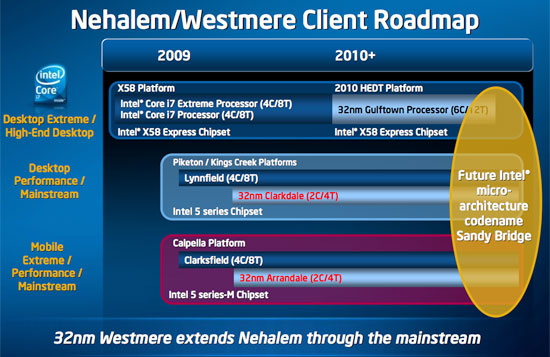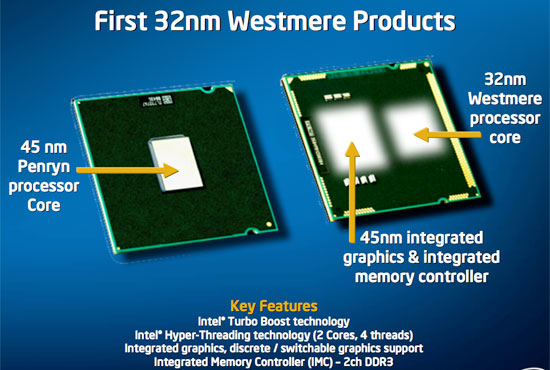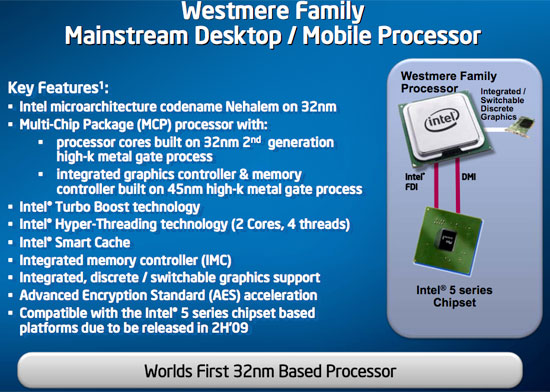Intel's 32nm Update: The Follow-on to Core i7 and More
by Anand Lal Shimpi on February 11, 2009 12:00 AM EST- Posted in
- CPUs
Enter the 32nm Lineup
Instead of Havendale in Q4, we’ll get Clarkdale and Arrandale. These are both dual-core, quad-thread processors, and both have on-package graphics. The CPU cores will be built on Intel’s 32nm process and in fact, they will be the first Westmere CPUs shipping into the market.

Now note that the dual-core market is the largest slice of the processor pie. Intel must be incredibly confident in its 32nm process to start shipping it into these demand markets first. Remember that both 65nm and 45nm initially launched on the high end desktop, but 32nm is making its debut in mainstream notebooks and desktops. The 32nm ramp is going to be a good one folks.
| Segment | Manufacturing Process | Socket | Processor | Cores | Threads | Release Date |
| High End Desktop | 32nm | LGA-1366 | Gulftown | 6 | 12 | 1H 2010 |
| Mainstream Desktop | 32nm | LGA-1156 | Clarkdale | 2 | 4 | Q4 2009 |
| Mobile | 32nm | mPGA-989 | Arrandale | 2 | 4 | Q4 2009 |
| 4S Server | 32nm | LGA-1567 | ??? | ? | ? | 2010 |
| 2S Server | 32nm | LGA-1366 | ??? | ? | ? | 2010 |
| 1S Server | 32nm | LGA-1156 | Clarkdale | 2 | 4 | 2010 |
Clarkdale/Arrandale have 32nm CPUs but their on-package GPUs are still built on Intel’s 45nm process; these are the GPUs that were supposed to be used for Havendale! It won’t be until 2010 with Sandy Bridge that we see a 32nm CPU and 32nm GPU on the same package.

A side effect of the Clarkdale/Arrandale architecture is that the memory controller is now located on the GPU and not the CPU, although both are still on package and should still be quite low latency.

Keep following; if you want a quad-core Westmere, your only option will be in the LGA-1366 socket with Gulftown. Core i7 will get replaced with a six-core, twelve-thread processor in early 2010. There won’t be a 32nm quad-core part on the desktop until the end of 2010 with Sandy Bridge.










64 Comments
View All Comments
Oyvind - Wednesday, April 15, 2009 - link
7 - 10 post are about the fact that todays sw don't use more than 2 cores in a efficent way. Well 2 - 3 years ago, there was close to none. Did Valve, Epic and others build frameworks for using multi cpu's before the hardware base was in place. The answer is no. Do most big software house today put a big effort in scaling over more cores? The answer is yes. Should Intel/Amd wait until the sw houses catch up? I don't understand it, but the spoken majority seems to answer this with a yes?My question: When the big sw house is done with the mulri cpu frameworks, do you son't belive they then will scale over n numbers of cpu's. Userinput, rendering/gpu stuff, AI x n the deept of today etc. All real lifte arhitechure is paralell, sw is not yet, but hopefully that will change.
----
If lifte is good, and you have insane to much money, you stop developing, you dont need to priortize and you slowly fall back in your pillow. Yes AMD fight uphill, but if they manage to survive, nature has proven that fhigting uneven odds, will give you and middel to long term edge (ok if you survive). Tons of money dont save anything. Not sure they suvive, but if they don't a new company with clever enginers will rise somwhere in the future. Yes we need competition and there always will be.
mattigreenbay - Friday, March 6, 2009 - link
This is the end of AMD. Unless this turns out like P4 (not likely), AMD will have to release their process first or soon after [or better yet, a 16nm ultra-fast processor, and while I'm still dreaming, make it free] and have it perform better (also not likely). Poor AMD. I was going to buy a Phenom II, but Intel seems the way to go, future-wise. AMD will be liquidated, as well as VIA and Intel will go back to selling way overpriced processors that perform less than a i386 [Windows 7 certified].mattigreenbay - Friday, March 6, 2009 - link
But it'll come with a free super fast Intel GPU. (bye bye Nvidia too) :(arbiter378 - Sunday, November 22, 2009 - link
Intel doesn't make fast gpu's. Even when they tried with that agp gpu ati and nvidia killed it. They won't let a new playing into a graphics market with out a fight. Lastly intel has been trying to beat amd for 40 something years, and there still not even close to beating them. Now that amd has acquired amd they have superior graphics patents.LeadSled - Friday, February 20, 2009 - link
What is really amazing, is the shrink proccess timetable. It looks like they will meet the timetable for our first Quantum DOT procersors. It is theorized to occure at the 1.5nm proccess and by the year 2020.KeepSix - Saturday, February 14, 2009 - link
I guess I can't blame them for changing sockets all the time, but I'm not sure if I'll be switching any time soon. My Q6600 hasn't gone past 50% usage yet, even when extreme multi-tasking (editing HD video, etc.)I'd love to build an i7 right now, but I just can't justify it.
Hrel - Thursday, February 12, 2009 - link
On the mainstream quad-core side, it may not make sense to try to upgrade to 32nm quad-core until Sandy Bridge at the end of 2010. If you buy Lynnfield this year, chances are that you won’t feel a need to upgrade until late 2010/2011.So if you buy a quad core 8 thread 3.0 Ghz processor you will "NEED" to upgrade in one year?! What?! It doesn't make sense to upgrade just for the sake of having the latest. Upgrade when your computer can't run the programs you need it to anymore; or when you have the extra money and you'll see at least a 30 percent minimum increase in performance. You should be good for at least 2 years with Lynnfield and probably 4 or 5 years.
QChronoD - Thursday, February 12, 2009 - link
He's saying that the people who have no qualms about throwing down a grand on just the processor are going to want to upgrade to the 32nm next year.However for the rest of us that don't shit gold, picking up a Lynnfield later this year will tide us over until 2011 fairly happily.
AnnonymousCoward - Thursday, February 12, 2009 - link
> However for the rest of us that don't shit gold, picking up a Lynnfield later this year will tide us over until 2011 fairly happily.My C2D@3GHz will hold me over to 2011...
MadBoris - Thursday, February 12, 2009 - link
I watch roadmaps from time to time and I know where AMD has potential.Simplify the damn roadmap, platforms, chipsets, sockets!
Seriously, I need a spread sheet and calculator to keep it all straight.
Glad Anand gave kind of a summary for were and when it makes sense to upgrade but I just don't have the patience to filter through it all to the end I get a working knowledge of it.
One thing AMD has been good at in the past if they continue, is to keep upgrades simple. I don't want a new motherboard and new socket on near every CPU upgrade. I'm not sure if mobo makers love it or hate it, obviously they get new sales but it's kind of nuts.
This alone, knowing I have some future proofing on the mobo, makes CPU upgrades appealing and easy and something I would take advantage of.
As far as the GPU/CPU it's nothing I will need for years to come. We will have to wait until it permeates the market before it gets used by devs, just like multicore. It will at least take consoles implementing it before game devs start utilizing it, and even then it's liable to take a lot of steps back in performance (it's only hype now)...